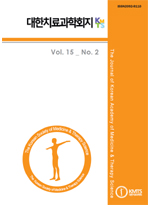백색잡음 환경에서 귀덮개 사용이 변조이음향방사 신호대잡음비에 미치는 영향
Effects of Earmuff Using on Signal-to-Noise Ratio of Distortion Product OtoAcoustic Emission in White Noise Environments
- 대한치료과학회
- 대한치료과학회지
- Vol. 15, No. 2
-
2023.1169 - 77 (9 pages)
-
DOI : 10.31321/KMTS.2023.15.2.69
- 21

Objective: Earmuff has been shown to attenuate noise and may be useful in boothless audiometry. This study aimed to determine the effect of earmuff use on the signal-to-noise ratio of distortion production otoacoustic emission (DPOAE) in a white noise environment. Method: Participants were 19 young, healthy men and women (38 ears) aged 22.45±1.31 years. The hearing threshold level in 1, 2, 3, and 4 ㎑ did not exceed 15 ㏈ HL. DPOAE was performed at four points per octave in the range 842 to 9,509 ㎐ based on f2. After obtaining the baseline (Base), white noise was presented at 10 ㏈ intervals from 40 to 70 ㏈ SPL. DPOAE was obtained without (WN) and with earmuff (Earmuff). The maximum permissible ambient noise level (MPANL) of the WN and Earmuff were compared (paired t-test). Signal-to-noise ratio (one-way repeated measures ANOVA) and PASS rate (Chi-square test) between WN, Earmuff and Base at the overall frequency, mid-frequency (mid-3-freq), and high-frequency (hi-3-freq) bands were analyzed. Results: There was a difference of 22.19 ㏈ in MPANL between Base and WN (p=.000). There was a significant difference in the SNR between Base and WN from 40 ㏈ SPL, and in PASS rate between Base and Earmuff from 60 SPL (p<.005). Conclusion: In DPOAE, earmuff increase MPANL, which enables recording at up to 60 ㏈ SPL. The SNR in the high-frequency band is more preserved than in the lower, Therefore, it seems advantageous for early detection of cochlear microstructural changes due to noise or aging.
Ⅰ. 서론
Ⅱ. 연구 대상 및 방법
Ⅲ. 연구 결과
Ⅳ. 고찰
Ⅴ. 결론
참고문헌
(0)
(0)